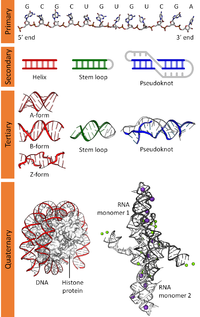Nucleic acid structure

Nucleic acids are like the blueprint or instruction manual for how cells should work. They are made up of tiny building blocks called nucleotides, which are strung together like beads on a necklace.
The nucleotides are made up of three parts: a sugar (called deoxyribose or ribose), a phosphate group, and a nitrogen-containing base. There are four different nitrogen-containing bases: adenine (A), guanine (G), cytosine (C), and thymine (T) in DNA, and uracil (U) in RNA.
The nucleotides are connected together by chemical bonds between the sugar and the phosphate groups, forming long chains that can be thousands or millions of nucleotides long. The nitrogen-containing bases stick out from the chain like branches on a tree, and they pair up with each other in specific ways: A always pairs with T (or U), and G always pairs with C.
This base-pairing is what gives nucleic acids their structure. In DNA, the two chains of nucleotides twist together into a double helix shape, with the base pairs forming the "rungs" of the ladder. In RNA, the structure can be more varied, but it still involves base pairing between two or more chains of nucleotides.
The specific sequence of nucleotides along the chain determines the information that the nucleic acid contains. This sequence can be translated into proteins, which are the workhorses of the cell. Understanding the structure of nucleic acids is crucial for understanding how cells work and for developing new therapies for genetic diseases.
The nucleotides are made up of three parts: a sugar (called deoxyribose or ribose), a phosphate group, and a nitrogen-containing base. There are four different nitrogen-containing bases: adenine (A), guanine (G), cytosine (C), and thymine (T) in DNA, and uracil (U) in RNA.
The nucleotides are connected together by chemical bonds between the sugar and the phosphate groups, forming long chains that can be thousands or millions of nucleotides long. The nitrogen-containing bases stick out from the chain like branches on a tree, and they pair up with each other in specific ways: A always pairs with T (or U), and G always pairs with C.
This base-pairing is what gives nucleic acids their structure. In DNA, the two chains of nucleotides twist together into a double helix shape, with the base pairs forming the "rungs" of the ladder. In RNA, the structure can be more varied, but it still involves base pairing between two or more chains of nucleotides.
The specific sequence of nucleotides along the chain determines the information that the nucleic acid contains. This sequence can be translated into proteins, which are the workhorses of the cell. Understanding the structure of nucleic acids is crucial for understanding how cells work and for developing new therapies for genetic diseases.
Related topics others have asked about:
Biomolecular structure,
Crosslinking of DNA,
DNA nanotechnology,
DNA supercoil,
Gene structure,
Non-helical models of DNA structure,
Nucleic acid design,
Nucleic acid double helix,
Nucleic acid structure determination,
Nucleic acid structure prediction,
Nucleic acid thermodynamics,
Protein structure
